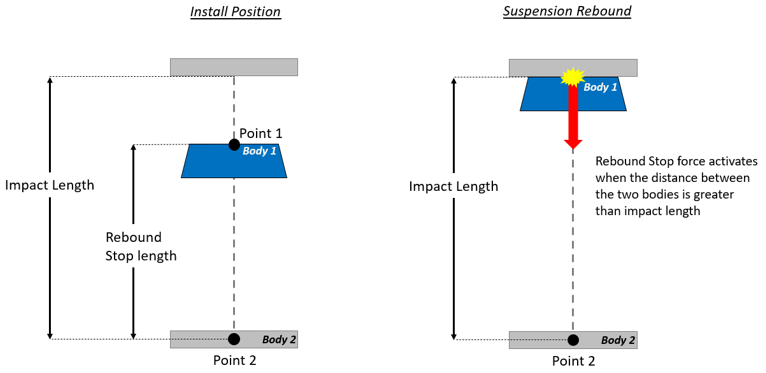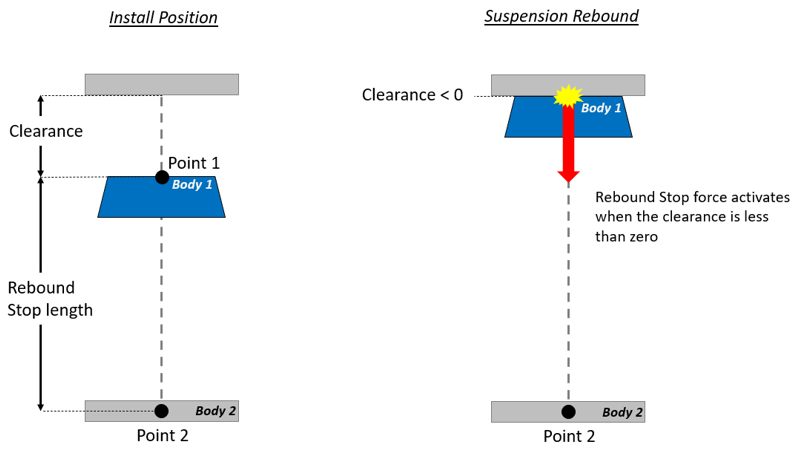Rebound Stop
The Rebound Stop component limits the suspension travel in rebound (also known as droop). When the distance between two bodies becomes large, the Rebound Stop applies a force to pull the bodies together.
The Rebound Stop force can be a linear or non-linear type and is computed from the force versus displacement table stored in a TeimOrbit format property file.
For a linear Rebound Stop, the elastic force component is calculated using a third order polynomial, and for a non-linear Rebound Stop the elastic force component is interpolated using the Akima method.
Parameters
- Property File
- The Rebound Stop properties are stored in a TeimOrbit format property file containing a table of the force versus displacement.
- Install Method
- The install method is used to determine the distance at which the Rebound Stop force
starts acting. There are two install methods available:
- Impact LengthThe impact length represents the distance between the Rebound Stop attachment points when the impact happens.

Figure 1. Impact Length methodWhen the distance between the Body 1 and Body 2 is greater than the impact length, the Rebound Stop force acts. When the Impact Length install method is used, its value is directly used to activate the Rebound Stop force between the two bodies.
- ClearanceUsing the clearance method, the Rebound Stop force is activated when the distance between the Body 1 and Body 2 is greater than the Rebound Stop Length minus the Clearance value, that is, when the clearance reaches a value lower than zero.

Figure 2. Clearance method
- Impact Length
- Install Distance
- The install distance represents the value of the selected install method. If Impact Length method is selected, the install distance value describes the impact length value. If the clearance method is selected, the install distance describes the clearance value.
- Rebound Stop length
- The rebound stop length is the distance between the Point 1 and Point 2 defined in the modeling configuration. This parameter is not editable and is only used to demonstrate the current rebound stop length before the simulation.
- Scale
- The scale options enable the scaling of the force and displacement without the need to directly modify the property file.
- Graphics
- Two cylinder graphics represents the Rebound Stop in MotionView. This parameter allows modify the Cylinder One and Cylinder Two radius for the visualization purpose.
Connecting a Rebound Stop
-
1. From the guidebar, select the first body to connect.
- Click Body 1 and select a
body from the modeling window.
OR
- Click the Body 1 Advanced Selector and select the required body from the dialog.
- Click Body 1 and select a
body from the modeling window.
- Similarly, select the second body to connect by clicking the Body 2 input collector.
-
Select a point and enter the location where the spring connects to Body
1.
- Click Point on Body 1 and select a point from the
modeling window.
OR
- Click the Point on Body 1 Advanced Selector and select the required point from the dialog.
- Click Point on Body 1 and select a point from the
modeling window.
- Similarly, select the second point by clicking the Point 2 on Body 2 input collector.
- Open the Rebound Stop Entity Editor to edit the parameters.
Property File
The Rebound Stop properties are stored in a in a TeimOrbit format property file. When the model is submitted to the solver, MotionSolve reads the BumpStop property file for use during simulation. If the units in the property file differ from the model units, the solver internally converts the properties to the model units, however it leaves the property file unchanged.
The Rebound Stop property file contains header, units, and curve blocks. The units block specifies the length, mass, force, time, and angle units employed in the file. The curve block holds a table of displacement against force values for the elastic force component.
$--------------------------------------------------------------------HEADER
[HEADER]
FILE_TYPE = 'reb'
FILE_VERSION = 4.0
FILE_FORMAT = 'ASCII'
$---------------------------------------------------------------------UNITS
[UNITS]
LENGTH = 'mm'
ANGLE = 'degrees'
FORCE = 'newton'
MASS = 'kg'
TIME = 'second'
$---------------------------------------------------------------------CURVE
[CURVE]
{ disp force}
0.0 0.0
2.0 1.0
4.0 2.0
6.0 3.0
8.0 4.0
10.0 5.0
20.0 6.0
30.0 7.0
40.0 8.0
50.0 9.0Outputs
| Type | Component | Quantity |
|---|---|---|
| User Defined (.plt) REQSUB (.abf) |
Reboundstop Output | Distance between points |
| Rate of change of displacement | ||
| Rebound Stop Force | ||
| Direction Cosine - X | ||
| Direction Cosine - Y | ||
| Direction Cosine - Z |